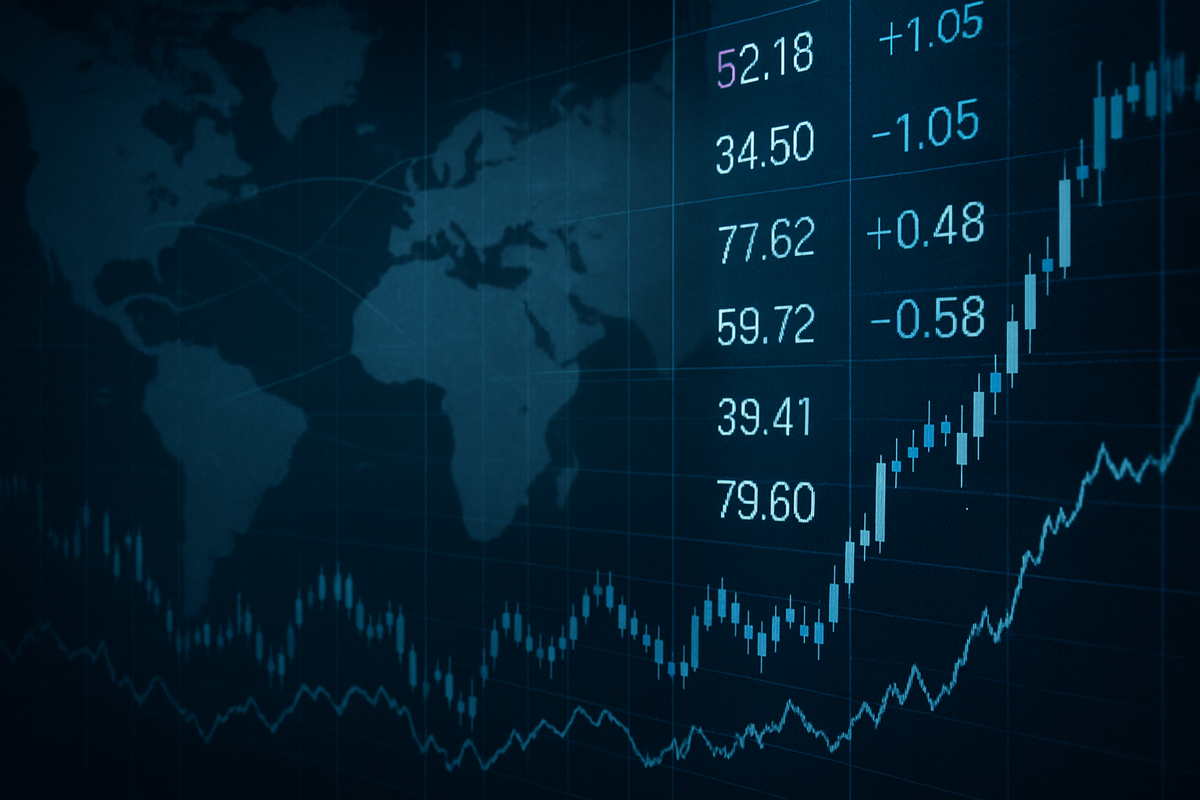
As the first-quarter earnings season draws to a close, investors are meticulously sifting through corporate reports, seeking clarity amidst a landscape increasingly clouded by geopolitical tensions and the looming specter of tariffs. While major Indian conglomerates like SBI, Tata Motors, Siemens, and Info Edge have been under intense scrutiny for their financial performance, a more pervasive concern has emerged from the United States, where a growing number of S&P 500 companies are issuing cautionary statements regarding the potential negative impact of current tariffs on their profitability and operational stability. This confluence of earnings results and tariff anxieties is setting a cautious tone for the market, prompting a re-evaluation of investment strategies and corporate resilience.
The immediate implications are palpable: market volatility is on the rise as investors grapple with uncertainty. Companies with significant international supply chains or those heavily reliant on imported raw materials are particularly vulnerable, facing increased costs and potential disruptions. Conversely, domestic-focused businesses or those with strong export capabilities to non-tariffed regions might find themselves in a relatively stronger position. The earnings season, typically a period of fundamental assessment, has thus transformed into a critical barometer for gauging corporate adaptability in the face of evolving trade dynamics.
Tariffs Take Center Stage as Earnings Season Winds Down
The Q1 earnings season, which commenced in earnest in mid-April, is now in its final stages, with the majority of S&P 500 companies having reported their results. While many companies have delivered solid top-line growth, the narrative has increasingly shifted from past performance to future guidance, particularly concerning the impact of trade policies. The primary concern revolves around the tariffs imposed by various nations, most notably between the United States and China, which have escalated over the past year. These tariffs, essentially taxes on imported goods, are designed to protect domestic industries but often result in higher costs for businesses and consumers, disrupt established supply chains, and can trigger retaliatory measures.
Companies across diverse sectors, from manufacturing and retail to technology, have begun to quantify the financial hit from these tariffs. Many S&P 500 companies, during their earnings calls, have highlighted increased input costs, reduced profit margins, and the need to re-evaluate sourcing strategies. This trend has been a significant development, as initial tariff impacts were often absorbed or mitigated, but their prolonged presence and expansion are now forcing companies to make more fundamental adjustments. The timeline of events leading to this moment includes several rounds of tariff announcements and counter-announcements, creating a volatile and unpredictable trade environment. Key players involved are not just the companies themselves, but also governments, trade organizations, and, ultimately, consumers who bear the brunt of higher prices. Initial market reactions have been mixed, with sectors perceived as vulnerable experiencing sell-offs, while those seen as insulated or even beneficiaries have shown resilience.
Navigating the Tariff Tides: Identifying Winners and Losers
The current tariff environment is creating a distinct bifurcation in the market, clearly delineating potential winners and losers based on their operational models, supply chain resilience, and market exposure. Companies with extensive global supply chains, particularly those heavily reliant on imports from tariff-affected regions, are facing significant headwinds. For instance, Tata Motors (NSE: TATAMOTORS), with its global footprint and significant operations in various international markets, could face challenges related to increased material costs or reduced demand in tariff-im''pacted regions, especially concerning its Jaguar Land Rover subsidiary which has exposure to the US and Chinese markets. Similarly, Siemens (NSE: SIEMENS), a global industrial giant, could see its margins squeezed by higher costs for components or raw materials if its supply chain is exposed to tariffed goods, potentially impacting its diverse portfolio from energy to healthcare technology.
Conversely, companies with a strong domestic focus or those that can easily pivot their supply chains to non-tariffed countries might emerge relatively unscathed or even gain a competitive edge. Financial institutions like SBI (NSE: SBIN) are less directly impacted by tariffs on goods, though a broader economic slowdown due to trade tensions could indirectly affect loan growth and asset quality. Technology and service-oriented companies, such as Info Edge (NSE: NAUKRI), which operates online classifieds and recruitment platforms, are generally more insulated from direct tariff impacts on physical goods. However, a general downturn in business sentiment or reduced corporate spending due to economic uncertainty could still affect their advertising and recruitment revenues. Ultimately, the ability of companies to absorb higher costs, pass them on to consumers, or strategically reconfigure their operations will determine their standing in this evolving trade landscape.
Broader Implications: Reshaping Industries and Global Trade
The tariff situation, amplified by the Q1 earnings season''s revelations, is not merely a transient blip but a significant force reshaping broader industry trends and global trade dynamics. This event fits squarely into a larger narrative of deglobalization or, at the very least, a re-evaluation of highly interconnected global supply chains. For decades, companies optimized for efficiency and cost-effectiveness by sourcing components and manufacturing in the most economical locations worldwide. Tariffs are now forcing a painful recalculation, prioritizing resilience and geopolitical stability over pure cost savings. This could lead to a trend of "reshoring" or "nearshoring" production, bringing manufacturing closer to end markets, even if it means higher operational costs.
The ripple effects are profound. Competitors and partners within the same industry are being forced to reassess their own strategies. Companies that can quickly adapt their supply chains, diversify their sourcing, or innovate to reduce reliance on tariffed inputs will gain a competitive advantage. Conversely, those locked into rigid global networks face significant disadvantages. From a regulatory and policy standpoint, the current tariff regime highlights the increasing weaponization of trade policy as a tool of foreign policy. This could lead to more bilateral trade agreements, regional blocs, and a more fragmented global trading system, moving away from the multilateral framework championed by organizations like the World Trade Organization (WTO). Historically, similar protectionist measures, such as the Smoot-Hawley Tariff Act of 1930, have been linked to exacerbating economic downturns, serving as a cautionary tale for policymakers and businesses alike. The current situation, while different in scope and context, echoes the potential for trade barriers to disrupt economic stability and foster uncertainty.
What Comes Next: Adaptation and Strategic Pivots
Looking ahead, the immediate future will be characterized by continued corporate adaptation and strategic pivots in response to the persistent tariff environment and the insights gleaned from Q1 earnings. In the short term, companies will likely focus on optimizing their existing supply chains, exploring alternative sourcing options, and negotiating with suppliers to mitigate cost increases. We can expect to see more companies passing on some of these increased costs to consumers, which could lead to inflationary pressures in certain sectors. For investors, monitoring companies'' guidance on tariff impacts and their strategies for mitigation will be paramount.
In the long term, the implications are more profound. Companies may accelerate investments in automation and advanced manufacturing technologies to reduce labor costs and reliance on international supply chains. There could also be a significant shift towards regionalized production hubs, where goods are manufactured closer to their final markets to circumvent trade barriers. This could create new market opportunities for logistics, warehousing, and domestic manufacturing sectors. However, it also presents challenges, as it requires substantial capital expenditure and a re-evaluation of established business models. Potential scenarios range from a de-escalation of trade tensions, which would provide a much-needed boost to global trade, to a further entrenchment of protectionist policies, leading to a more fragmented and less efficient global economy. Companies that can demonstrate agility, innovation, and a robust risk management framework will be best positioned to navigate these turbulent waters.
Conclusion: A New Era of Trade Uncertainty
The conclusion of the Q1 earnings season, overshadowed by the pervasive influence of tariffs, marks a pivotal moment for the global financial markets. The key takeaway is clear: trade policy has moved from the periphery to the center stage of corporate financial planning. Companies are no longer just contending with market demand and operational efficiency; they must now factor in the unpredictable and often costly implications of international trade disputes. The assessment of the market moving forward suggests a period of heightened caution and selective investment. Sectors and companies with strong domestic foundations, diversified supply chains, or those offering essential services less susceptible to trade wars may prove more resilient.
The lasting impact of this period could be a fundamental re-evaluation of globalization itself, leading to more localized production and a greater emphasis on national economic security. For investors, the coming months will demand a keen eye on corporate guidance, particularly concerning supply chain adjustments, pricing strategies, and capital expenditure plans related to reshoring or nearshoring. Furthermore, monitoring geopolitical developments and trade negotiations will be as crucial as analyzing traditional financial metrics. The era of seamless global trade, as we knew it, appears to be evolving, and only those companies and investors who can adapt to this new, more complex landscape will truly thrive.





